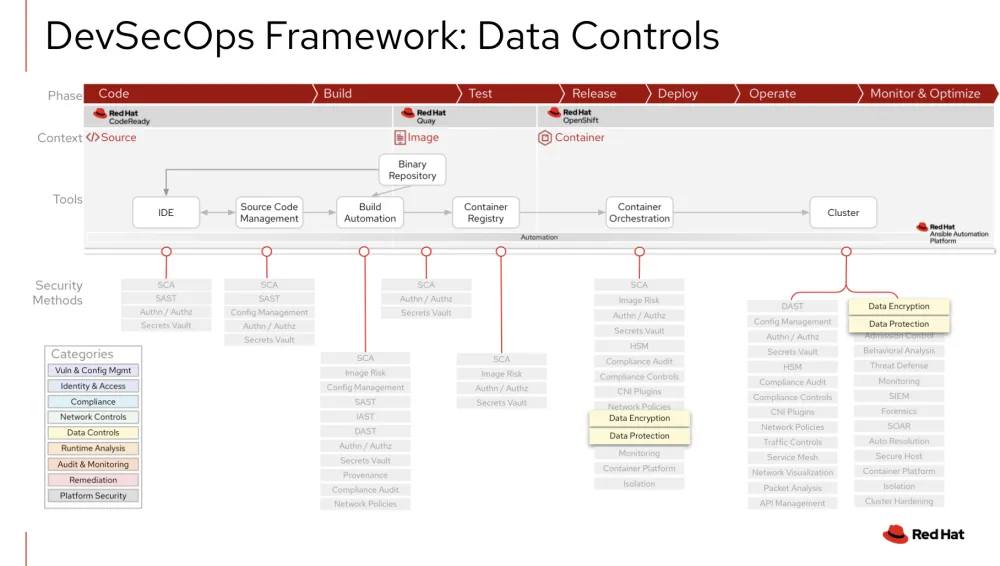In this post:
-
Explains the concept of data controls.
-
Shows how data controls integrate into the framework at the container orchestration and cluster level.
-
Pointers to Red Hat partners that can help with data controls.
Data controls help protect data integrity and prevent unauthorized data disclosure for stored data and data in motion. In this post we'll dive deeper into the concepts of data controls and how they fit into the DevSecOps framework.
July is “Data Controls” month in Red Hat’s monthly Security series! Since March 2021, the Red Hat Security Ecosystem team has published monthly articles and videos on DevOps Security topics to help you learn how Red Hat can help you master the practice called DevSecOps.
By explaining how to assemble Red Hat products and introducing our security ecosystem partners, we aim to aid in your journey to deploying a comprehensive DevSecOps solution.
Data controls defined
Data controls are typically implemented in a running Kubernetes cluster, and the goal is to provide a defense in depth approach to protect sensitive data either at rest or in motion. The following security methods make up the Data Controls category:
-
Data encryption: Provides data cryptography, tokenization, data masking, and key management capabilities to help prevent unauthorized disclosure of data in databases, files, and containers.
-
Data protection: Discovers and classifies data and monitors and audits activity to help protect sensitive data and improve compliance.
Data controls integrated in DevSecOps
As pictured in the DevSecOps framework below, data controls integrations are typically found on the right side of the DevSecOps life cycle in a running cluster. The table that follows details some, but not all, of the common integrations to consider for Data Controls.

|
Integration Point |
Description |
|
Container Orchestration and Cluster |
Data Control integrations in both container orchestration and the running cluster provide the same functionality as described below. Whether you are testing, releasing, deploying, operating or monitoring the cluster, these controls need to be considered. With Red Hat OpenShift Container Platform, you can enable etcd encryption, which provides an additional layer of data security for Secrets, Config maps, Routes, and OAuth tokens. This can help protect data if it's exposed to the wrong parties. Data in-transit encryption is all about certificates and securing the ingress and egress traffic within a cluster. One of the many certificate types to address in the default API server certificate provided by the OpenShift Container Platform. For example, if you need clients outside of the cluster to access any running web applications, you’ll need to replace the certificate with a Certificate Authority that the client's trust. In order to centrally manage, store and further protect OpenShift keys and certificates for data controls, you’ll want to extend and enhance OpenShift Container Platform’s data security capabilities with certified partner software that centralizes data encryption across environments and adds layers of data protection. Red Hat’s partner ecosystem can help add:
Data protection in a running cluster can also include discovering where sensitive data exists in your cluster, as well as analyzing data risks and uncovering suspicious activity against the data in rest. |
Enhance and extend Data Controls with Red Hat partners
Combining Red Hat OpenShift Container Platform Data Control features with Red Hat’s certified ecosystem security partners can help your organization's DevSecOps practice.
If you are looking to enhance and extend Red Hat’s security capabilities in Data Controls, take a look at the following Red Hat Partners:
-
Zettaset’s certified software, product brief and webinar.
-
Thales’ Red Hat solution brief and webinar.
About the author
Dave Meurer currently serves as a Principal Solution Architect on the Red Hat Global Partner Security ISV team, where he owns technical relationships and evangelism with security independent software vendor partners of Red Hat. Before joining Red Hat, he spent nine years in the Application Security industry with Synopsys and Black Duck, where he served in similar roles as the director of technical alliances and sales engineering.
Meurer also worked for Skyway Software, HSN.com, and Accenture in various management and application development roles. When he’s not thinking about Kubernetes, security, and partners, he enjoys being the VP Sales of North Central Tampa for his wife (the CEO) and 5 kids (Inside Sales).
More like this
Red Hat to acquire Chatterbox Labs: Frequently Asked Questions
Attestation vs. integrity in a zero-trust world
What Is Product Security? | Compiler
Technically Speaking | Security for the AI supply chain
Browse by channel
Automation
The latest on IT automation for tech, teams, and environments
Artificial intelligence
Updates on the platforms that free customers to run AI workloads anywhere
Open hybrid cloud
Explore how we build a more flexible future with hybrid cloud
Security
The latest on how we reduce risks across environments and technologies
Edge computing
Updates on the platforms that simplify operations at the edge
Infrastructure
The latest on the world’s leading enterprise Linux platform
Applications
Inside our solutions to the toughest application challenges
Virtualization
The future of enterprise virtualization for your workloads on-premise or across clouds
